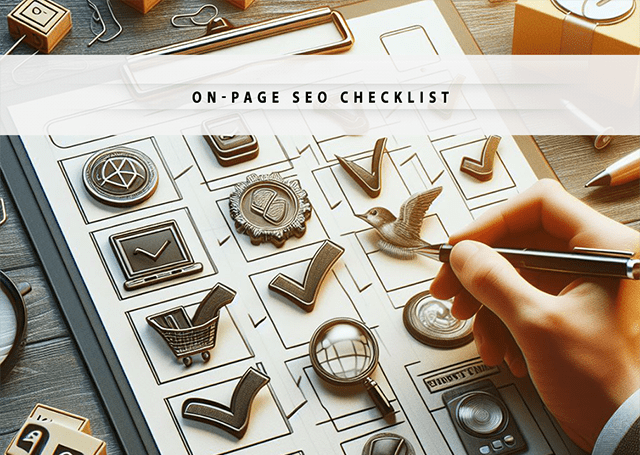
Understanding On-Page SEO
Contents
- 1 Understanding On-Page SEO
- 2 Keyword Research: The Foundation of On-Page SEO
- 3 Optimizing Title Tags and Meta Descriptions
- 4 Content Optimization Strategies
- 5 Technical On-Page SEO Elements
- 6 Visual Content and Multimedia Optimization
- 7 User experience (UX) and Engagement Factors
- 8 Local SEO Considerations
- 9 Monitoring and Continuous Improvement
- 10 Call to Action
In today’s competitive digital marketing world, having a robust on-page SEO checklist is important for ensuring your content ranks well in search engines like Google. On-page SEO involves optimizing individual web pages in order to rank higher and earn more search traffic.
As mentioned earlier, On-page SEO refers to the practice of optimizing individual web pages to rank higher and earn more relevant traffic in search engines. It involves both the content and HTML source code of a page that can be optimized, as opposed to off-page SEO which refers to links and other external signals.
Implementing a thorough on-page SEO checklist is essential because it helps search engines understand your website and its content, as well as identify whether it is relevant to a searcher’s query. By following this checklist, you’ll be able to create pages that are fully optimized for both search engines and human visitors.
Keyword Research: The Foundation of On-Page SEO
Before diving into on-page optimization, it’s crucial to conduct thorough keyword research. This forms the foundation of your on-page SEO strategy. Proper keyword optimization involves balancing keyword density and placement to avoid keyword stuffing while ensuring relevance.
Keyword Selection Criteria:
| Criteria | Description |
|---|---|
| Search Volume | The number of monthly searches for the keyword |
| Relevance | How closely the keyword aligns with your content and business |
| Competition | The difficulty of ranking for the keyword |
| Intent | The purpose behind the user’s search query |
Steps for Effective Keyword Research:
- Identify 1-2 primary target keywords for each page
- Find 5-10 secondary keywords to incorporate naturally
- Aim for a keyword density of 1-2%
- Use keyword research tools like Google Keyword Planner, SEMrush, and Ahrefs
- Analyze top-ranking pages for your target keywords
- Group related keywords to create a semantic field
- Place keywords in the first 100 words, title, headers, and throughout the content naturally
- Consider user search intent (informational, navigational, commercial, transactional)
Remember, the goal is to find keywords that have a good balance of search volume, relevance to your content, and achievable competition levels.
Optimizing Title Tags and Meta Descriptions
Title tags and meta descriptions are crucial on-page SEO elements that appear in search engine rankings pages (SERPs). Optimizing these elements can significantly impact your click-through rates and search rankings.
Meta tags are essential for helping search engines understand the content of your page. The two primary types of meta tags are the title tag and meta description.
Title Tag Best Practices:
- Keep it under 60 characters to avoid truncation in SERPs
- Include your primary target keyword
- Make it compelling and click-worthy
- Use brackets or parentheses to make it stand out
- Include a branded element to build awareness and trust
Example:
<title>On-Page SEO Checklist 2024: 25 Tips to Boost Rankings [Expert Guide]</title>Meta Description Best Practices:
- Write a compelling description under 160 characters
- Include a clear call-to-action
- Incorporate your primary keyword naturally
- Provide a concise summary of the page content
- Make it unique for each page
Example:
<meta name="description" content="Master on-page SEO with our comprehensive 2024 checklist. Learn 25 expert tips to optimize your content, boost rankings, and drive more organic traffic. Start now!">Content Optimization Strategies
Creating high-quality, optimized content is at the heart of successful on-page SEO. Here are key strategies to ensure your content is fully optimized:
Header tags help structure the content, making it easier for search engines to understand the hierarchy and relevance of information on a page.. Using header tags (H1, H2, H3, etc.) correctly can significantly enhance the readability and SEO of your content.
- Use only one H1 tag per page
- Keep it under 70 characters
- Include your primary target keyword
- Make it compelling and descriptive
H2 and H3 Tags:
Utilize these for subheadings to structure your content logically. Include variations of your target keywords naturally.
Optimize Content Structure:
Content Optimization Strategies Effectiveness Score
- Use your target keyword in the first 100 words
- Break up content with subheadings (H2, H3 tags) every 200-300 words
- Use short paragraphs and sentences for improved readability
Content Quality:
High-quality content is crucial for both user engagement and search engine rankings.
Content Length vs. Average Ranking Position
Key Elements:
- Original and valuable information.
- Comprehensive coverage of the topic.
- Regular updates to keep content fresh.
Keyword Usage and Density:
- Use synonyms and related keywords throughout the content
- As said earlier, aim for a natural keyword density of 1-2%
- Avoid keyword stuffing; write for humans first, search engines second
Content Length and Quality:
- Aim for at least 1000 words to provide depth and detail
- Ensure content is high-quality, accurate, original, and engaging
- Focus on providing value to users
Formatting for Scannability:
- Use bullet points and numbered lists
- Apply bold and italics to emphasize key points
- Include relevant images, charts, or infographics
Internal and External Linking:
- Internal linking enhances the navigability of your website and helps distribute link equity across pages.
- Link to other relevant internal pages on your site with descriptive anchor text
- Ensure all important pages are linked from other parts of your site.
Optimize for Featured Snippets:
- Answer common questions concisely and in a structured format
- Use tables, lists, and step-by-step instructions where appropriate
Readability:
- Use the Flesch-Kincaid readability test to ensure content is easy to understand
- Aim for a score of 60-70 for general audience content
By implementing these content optimization strategies, you’ll create engaging, informative content that appeals to both search engines and human readers.
Technical On-Page SEO Elements
While content is king, technical on-page SEO elements play a crucial role in how search engines crawl, index, and rank your pages. Here are key technical aspects to optimize:
URL structure:

A clean and descriptive URL structure not only aids search engines but also improves user experience.
- Keep URLs short, descriptive, and include the target keyword
- Use hyphens to separate words
- Avoid unnecessary parameters or session IDs
Schema markup:
Schema markup helps search engines understand your content better and can enhance your visibility in SERPs with rich snippets. So, implement relevant schema markup to provide additional context to search engines.
Implementation:
- Use JSON-LD format.
- Markup essential elements. Common types include Article, Product, Review, LocalBusiness and Events.
Page Speed Optimization:
Page speed is a critical ranking factor and significantly impacts user experience.
Optimization Tips:
- Minimize HTTP requests.
- Optimize images and use lazy loading.
- Leverage browser caching and enable GZIP compression.
- Use a content delivery network (CDN) for faster global access.
- Compress images and minify CSS, JavaScript, and HTML
Mobile optimization:
With an increasing number of users accessing the web via mobile devices, mobile optimization is non-negotiable.
Checklist:
- Ensure responsive design.
- Optimize loading speed for mobile.
- Avoid intrusive pop-ups.
- Ensure responsive design that works well on all devices
- Use Google’s Mobile-Friendly Test tool to identify and fix issues
XML Sitemap:
- Create and submit an XML sitemap to Google Search Console
- Keep it updated as you add or remove pages
Robots.txt File:
- Use the robots.txt file to guide search engine crawlers
- Ensure important pages are not accidentally blocked
Canonical Tags:
- Use canonical tags to prevent duplicate content issues
- Specify the preferred version of a page when multiple similar versions exist
HTTPS Security:
- Implement SSL certificate to secure your website
- Redirect HTTP to HTTPS to ensure all traffic is encrypted
By addressing these technical elements, you’ll create a solid foundation for your on-page SEO efforts and improve your chances of ranking well in search results.
Visual Content and Multimedia Optimization
Visual content and multimedia elements can significantly enhance user engagement and provide additional SEO benefits. Here’s how to optimize these elements:
Image Optimization:
- Alt text helps search engines understand the content of images, improving your chances of ranking in image searches.
- Use descriptive, keyword-rich file names to describe the image clearly
- Add alt text to all images, including target keywords where appropriate
- Compress images to reduce file size without sacrificing quality
- Include relevant keywords.
- Keep it concise and avoid keyword stuffing.
Video Optimization:
- Host videos on a fast, reliable platform (e.g., YouTube, Vimeo)
- Create engaging thumbnails to encourage clicks
- Provide transcripts or closed captions for accessibility and SEO
Infographics:
- Create informative, shareable infographics to attract backlinks
- Include an embed code to encourage sharing on other websites
User-Generated Content:
- Encourage reviews, comments, and forum discussions to add fresh content
- Moderate UGC to maintain quality and relevance
By incorporating optimized visual and multimedia content, you’ll improve user experience, increase time on page, and potentially earn more backlinks, all of which contribute to better search rankings result.
User experience (UX) and Engagement Factors
A positive user experience can lead to higher engagement and better rankings. Search engines increasingly consider user experience and engagement metrics when determining rankings. Here are key factors to optimize:
Page Load Speed:
- Aim for a page load time of under 3 seconds
- Use tools like Google PageSpeed Insights to identify improvement areas
Mobile Responsiveness:
- Ensure your site provides a seamless experience across all devices
- Test your site on various screen sizes and browsers
- Create a clear, logical site structure
- Use breadcrumbs to help users understand their location on your site
Reduce Bounce rate:
Impact of Bounce Rate on Organic Traffic
(Organic Traffic decreases as Bounce Rate increases)
- Create compelling, relevant content that matches search intent so as to reduce bounce rate
- Use internal links to encourage further exploration of your site
Increase Dwell Time:
- Provide in-depth, valuable content that keeps users engaged
- Use multimedia elements to enhance the user experience
Implement Clear CTAs:
- Guide users towards desired actions with clear, compelling calls-to-action
- Ensure CTAs are visible and easily clickable on mobile devices
- Use clear call-to-action buttons.
By focusing on these user experience and engagement factors, you’ll not only improve your SEO performance but also create a better overall experience for your website visitors.
Local SEO Considerations
If your business serves a specific geographic area, local SEO should be an integral part of your on-page optimization strategy. Here are key local SEO elements to consider:
Google My Business Optimization:
- Claim and verify your Google My Business listing
- Keep your business information accurate and up-to-date
- Encourage and respond to customer reviews
Local Keywords:
- Include location-specific keywords in your content, titles, and meta descriptions
- Create separate pages for each location you serve
NAP Consistency:
- Ensure your Name, Address, and Phone number (NAP) are consistent across your website and online directories
Local Content:
- Create content that’s relevant to your local audience
- Cover local events, news, or topics of interest
Local Backlinks:
- Seek backlinks from local businesses, organizations, and media outlets
- Participate in local events and sponsorships to earn mentions and links
By implementing these local SEO strategies, you’ll improve your visibility in local search results and attract more relevant, location-based traffic.
Monitoring and Continuous Improvement
On-page SEO is not a one-time task but an ongoing process of monitoring, analyzing, and improving. Here are key steps to ensure continuous improvement:
Use Google Search Console:
- Monitor your site’s performance in search results
- Identify and fix crawling or indexing issues
- Analyze click-through rates and average position for different queries
Track Key Metrics:
- Monitor organic traffic, bounce rate, and time on page
- Use tools like Google Analytics to track user behavior and conversions
Conduct Regular Audits:
- Perform bi-monthly or quarterly SEO audits
- Perform quarterly SEO audit checklist to identify areas for improvement
- Use tools like Screaming Frog or Ahrefs to automate parts of the audit process
Stay Updated with SEO Trends:
- Follow reputable SEO blogs and attend industry conferences
- Adapt your strategy based on algorithm updates and best practices
A/B Testing:
- Test different titles, meta descriptions, and content formats
- Use the results to refine your on-page SEO techniques strategy
By consistently monitoring and improving your on-page SEO techniques efforts, you’ll be able to maintain and improve your search rankings over time.
Call to Action
By following this comprehensive On-page SEO checklist, you can ensure your website is well optimized for search engines rankings, provides an excellent user experience and more organic traffic to your website. Remember, SEO is an ongoing process, so make sure to regularly review and update your on-page SEO techniques strategy to stay ahead of the competition and adapt to changes in search engine algorithms.

Ready to take your on-page SEO to the next level? Implement these strategies today and watch your organic traffic soar! For personalized SEO services, contact our expert team now!
On-Page SEO Checklist: Quick Reference Guide
- 1.
- 2.
- 3.
- 4.
- 5.
- 6.
- 7.
- 8.
- 9.
- 10.
- 11.
- 12.
- 13.
- 14.
- 15.
- 16.
- 17.
- 18.
- 19.
- 20.

